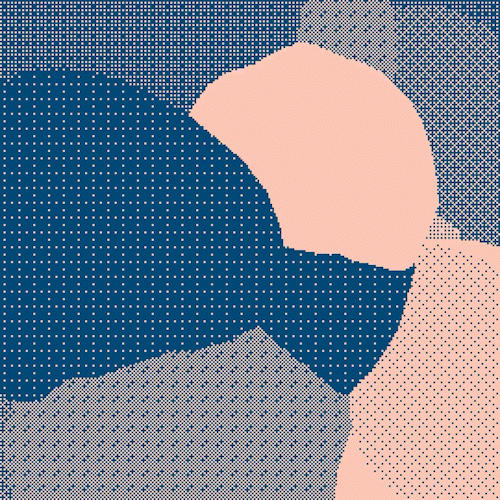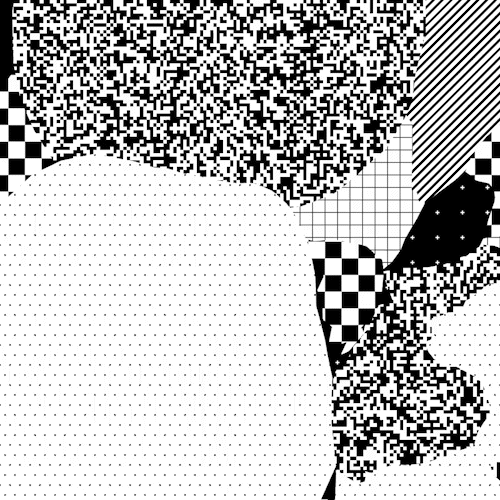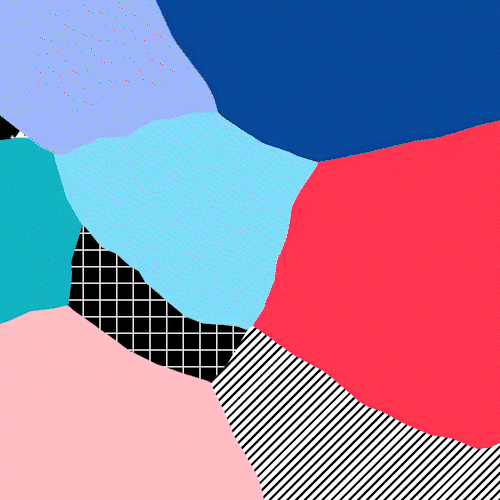THE MOTION ART JOURNAL: ANDERSON KOYA, ANIMATED PROCEDURAL PATTERNS
JANUARY 20TH, 2022
Based in Sao Paulo, Brazil, Anderson Koyma works as an industrial design lead in a healthcare company and has recently created some unique and compelling generative motion art.
His tool is Processing, as it is for many generative artists. His lineage is solidly in the tradition of well known procedural artists like Joshua Davis, Daniel Shiffman and Nicolas Sassoon who invited him to Foundation.
Much of his recent work is very fresh looking in its combination of flat organically moving shapes over static patterns of various types. Trying to describe generative work with words is difficult and doesn’t always do it justice. But Anderson Koyama has a light touch: His mixture of patterns, colors and organic shapes just…works. In DreamS.03 the palette is shades of red, black and grays is combined with dot patterns, a grid, and a field of gray pixelation which could be a photo. The movement of the organic shapes is deliberate. It is hard to stop looking at it. In EmergencE.06 organic shapes intertwine in a palette of pastel blues and pinks over various dot patterns that are similar, but different enough to keep your eye engaged.




Organic movement over a static pattern may not be new, but the way he executes it shows an instinct for color, composition and movement that shows real talent. I look forward to seeing more of his work in future.
Anderson Koyama was generous enough to answer a few questions from me.
Where did you grow up? Did you have art training?
I grew up in Sao Paulo. I have a bachelor degree in Design from the University of Sao Paulo majoring in visual and industrial design. The university Design school is part of the Architecture and Urbanism school, so I gained a general awareness of art history during my studies, but no formal art training.
How did you start making generative art?
When I was around 13 years old I used to mess around with Flash and ActionScript, so I always was a sucker for combining procedural thinking with motion graphics. But it was during my studies that I first encountered Processing, which was a game changer. I was already familiar with the work of Joshua Davis back when I was playing with Flash, but then Daniel Shiffman appeared and I had the opportunity to deepdive into processing + generative art without ‘proper’ computer science skills. He was an incredible teacher for me and a very inspiring person. I am also interested in exploring procedural thinking in the physical world using tools like Grasshopper + Rhino to create parametric designs.
How has your style evolved and what inspired you to work within a specific set of parameters the way you do?
I am fascinated with the principle of emergence and the reflexive process - where you don’t know exactly where it's going to end. I enjoy learning different techniques and mixing them in different ways to see what can emerge from it. Dithering, video feedback, pixel displacement, boids, particles, shaders, meshes, biomimicry algorithms - these are some of the techniques I am currently exploring.
I like the chaotic / random aesthetic that generative algorithms can create when combining multiple forms - there are infinite possibilities to explore.
What tools do you use to create your work?
Processing, P5js and GLSL shaders.
How long have you been in the NFT scene and how has it gone so far?
I got into NFTs in April with the Hic et Nunc platform. But at that time I didn’t give them much attention. It was only in September I decided to focus more effort, so I resurrected my Twitter account (lol) and started promoting my work and building connections. As a result of this I was invited to join Foundation, which raised my NFT artist profile. I’m very happy with my achievements so far considering my limited time in the NFT space. NFTs are not my main career right now - but who knows in the future, right. I’m glad that Tezos is now gaining popularity with fxhash. ETH has always bothered me because of its environmental impact. I’m hopeful that ETH 2.0 will change that scenario, contributing to a “cleaner” crypto ecosystem.
What artists do you like and follow?
There are so many of them. Every day I meet more, which is a good thing that the NFT community has provided. The following inspire me to name a few:
Joshua Davis - Someone that I’ve been following since I was a kid.
Manolo Gamboa - I love his aesthetics so much. He also inspired me to continue to use Processing as a general tool.
Nicolas Sassoon - My greatest NFT artist reference, someone I look up to and who has always supported my work.
Matt DesLauriers - I’m impressed how his work has been evolving.
Others: Itzel Yard, pixeldealer, loackme, itsgalo, Sofia Crespo, Zach Lieberman, A. L. Crego, lil code, luluxxx.
Brazilian artists: VJZZZZ, Leston, Alexandre Rangel, vamoss, glauberxyz, Monica Rizzolli.
Do you think that Motion Art is a new Art form as I lay out in my initial piece? Please be honest, some people just say 'no' and that is fine. I am just interested in the discussion...
In my opinion Motion Art is not new per se, but as part of the zeitgeist, it is a new art form. A unique form of cultural expression, a whole new language expressed through GIFs and videos with idiosyncratic interpretations that only makes sense when taking into account current technological and social developments.
I look forward to seeing Anderson’s development as an artist. His artistic instincts are exceptional and his curiosity should help him develop his art in new and interesting ways. See his just released ‘Flux’ collection for a hint of what’s to come.

